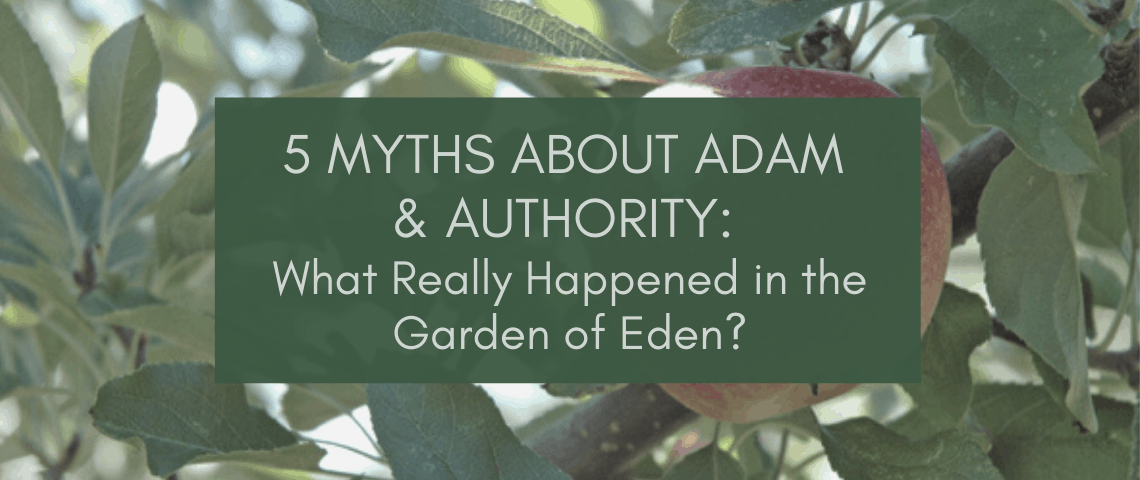There are some distorted messages being presented today about what happened in the Garden of Eden. For example, some are teaching that from the beginning of creation God ordained men to have authority and women to be under that authority. Here are some myths that lead to this misinterpretation of scripture:
Myth 1:
Adam named the animals in Eden; this means that he had authority over them. Adam named Eve; this means that he must have had authority over her also.
Truth 1:
“So God created man in His own image; in the image of God He created him; male and female He created them. Then God blessed them, and God said to them, ‘Be fruitful and multiply; fill the earth and subdue it; have dominion over the fish of the sea, over the birds of the air, and over every living thing that moves on the earth’.” (Genesis 1:27-28, NKJV).
Though Eve was not present when the animals were named (Genesis 2:19), male and female both had “dominion” over them. Adam named the animals and had authority over them. Adam did not have authority over the animals because he named them. Eve shared authority over the animals, even though she did not name them. Naming does not equal authority. As noted in a previous post, assuming that the man alone had authority over the animals is a contradiction of the biblical text. (It is also important to note that Eve was given her name after sin entered the world as described in Genesis 3.)
Myth 2:
Eve was created to be Adam’s “help-mate.” This means that she was designed to be his subordinate assistant, and to follow his lead.
Truth 2:
The expression “help-mate” does not occur in the Bible. It is a misunderstanding of the old English language used in the King James translation. Eve was a “help” that was “meet” for Adam. The term “help” (ezer in Hebrew) used in Genesis 2:18 comes from root words meaning “power” and “strength”, and is used repeatedly of God as a rescuer in the Old Testament. The term translated as “meet” (kenegdo in Hebrew) was an adjective used to modify the noun “help” and carries the connotation of being comparable. As explained here, a better translation would be that God gave Adam “a strength corresponding to him”.
Myth 3:
God made Adam, the man, before he made Eve. Being made first, chronologically speaking, is a clear indication of authority.
Truth 3:
The creation order for living things on earth, according to the Genesis account, proceeds as follows: aquatic life, birds, livestock, creatures that move along the ground, wild animals, mankind–male then female (Genesis 1:20-27, NIV). In this order of creation, animal life is made before humanity. If chronology equals rank, human beings should be subject to the animals. If, on the other hand, we assume that humanity should have dominion over the animals because we were created last, and are therefore the pinnacle of God’s creation, the woman would be God’s crowning achievement and should have dominion over all.
Assuming that the chronological order of creation equals rank, however, is not an idea that can be found in the Bible. It is merely a human assumption, one the Apostle Paul challenges in his first letter to the Corinthians: “Nevertheless, neither is man independent of woman, nor woman independent of man, in the Lord. For as woman came from man, even so man also comes through woman; but all things are from God” (1 Corinthians 11:11-12, NKJV).
Myth 4:
“In passing through ‘helpful’ animals to woman, God teaches us that the woman is a man’s ‘helper’ in the sense of a loyal and suitable assistant in the life of the garden.”[i]
Truth 4:
Before the creation of Eve, Adam is introduced to the following groups of animals: “livestock, the birds of the air, and all the beasts of the field” (Genesis 2:20, NIV). Which group of animals are we supposed to look to understand how women should relate to men? Thankfully, the Bible does not tell us that Adam’s relationship to livestock (or any other group of animals) gives us any indication of how men and women are expected to relate to one another. This myth is yet another example of human assumption.
Myth 5:
Adam’s mistake in the Garden was letting Eve usurp his leadership role. This is why it is important for men to “step up” and fulfill God’s call on their lives to be leaders in the church and in their homes.
Truth 5:
“Do not be called leaders; for One is your Leader, that is, Christ” (Jesus, Matthew 23:10, NASB). Jesus’ words about leaders are a stark contrast to the current rhetoric about male hierarchy in the church. Adam’s mistake was not about leadership but about disobedience.
Throughout the Genesis account Adam and Eve are depicted as equals.
They are equally created in God’s image (Genesis 1:27), they are given equal stewardship of all creation (Genesis 1:26). In Genesis 1:26 and 28, God tells both Adam and Eve to “rule” over the other living creatures. God never instructs Adam to rule over Eve. The first mention of any kind of authority dynamic between men and women occurs only after humanity has fallen into a sinful state (Genesis 3:16).
One would have to read a lot into these texts to come to the conclusion that God’s original design was for Adam to be in authority over Eve. The bottom line is that male hierarchy was not intended in creation as God’s original plan for men and women or for husbands and wives.
[i] Piper, J. & Grudem, W. Editors (2006). Recovering Biblical Manhood and Womanhood (p. 87). Wheaton, Illinois, Good News Publishers.




40 Comments
Posted this on my Facebook and only females liked it. I wish YOUNG men cared about these issues. They are really missing out in understanding scripture and the beauty of being with someone who is just as powerful as they are (perhaps in some kind of different way, but every bit as equal).
Thank you for sharing it on your Facebook page Jaymie. I’m glad to hear that the message is being shared. I’m also glad that you’ve received some positive feedback, though I agree with you that it would be nice to see a similar response from more young men. I know some wonderful young men who care deeply for the equality of women; my son is one of them. He’s truly one of the nicest people I’ve ever met in my life. He reflects the love of Christ.
P.S. I like your blog 🙂
One of the issues here is that people think that leader, means you must be a tyrant. In business one aspect of leadership is to delegate. So if your s
Let me say that again, if your spouse is good at some things and your not, then allowing them to look after that aspect of life, is an indication of good leadership.
Why would she need you to “allow” her to do what she is good at?
Most Christians around the world view the story of the Garden as an allegory, not a literal event. In that case though, the lessons from this article still fully apply. It’d be nice if the majority of Christians also heeded these lessons and weren’t still stuck in the middle ages. I thought all we had to do was wait for the old proponents to die off and things would change, but I keep running into relatively young people and pastors still espousing these views (among other bits of cherry-picked archaic views). Depressing. But also uplifting knowing there is more of a movement to change that.
It seems that this comment is off-topic. I must disagree with the premise that Genesis 1-3 is an allegory. It is written as history and is the foundation of God’s revelation. I am egalitarian and I am a creationist, both positions based upon God’s word in Genesis, and in the rest of Scripture.
This diversity of opinions about Adam is a good reminder that while we may share common views on egalitarianism, we don’t all come to that position from the same theological background. I would imagine it was the same for the abolitionists of times past when they worked together to do away with slavery. I am just becoming familiar with the issue of “the historical Adam” and am aware that it is a very contentious subject. I have always believed this to be an historical account myself, but have to admit I haven’t studied it much.
I would disagree with the statement that “most Christians around the world view the story of the Garden as an allegory”. Regardless of one’s personal views, it seems apparent that Paul viewed the story as historical and that’s important here.
I agree that the issue is irrelevant to the post, but also agree that either way, the points Bob makes are still applicable. Don’t see a need to remove the comment, as the observation made about the younger generation still buying into a complementarian reading that just isn’t there is valid.
Let’s not argue this issue here, though!
Nicely put Bob – I have just interviewed a lovely lady who was telling me woman couldn’t really teach and should be in submission because they are so emotional. I suggested she didn’t understand men, women or Scripture all that well.
Sisters, Scripture is emphatic that you are equal to us men, and what is more we need you with all your strengths, gifts and glory.
“Sisters, Scripture is emphatic that you are equal to us men, and what is more we need you with all your strengths, gifts and glory.” Beautifully said Mark. Thank you.
If someone says it is the fault of Eve that sin was introduced, trying to upset me, – my favorite reply is “Adam come could have said ‘NO!!!’ ” and they don’t have a reply. If that had happened, I wonder what would have been the outcome?
Indeed, Adam could have said “no.” Suggesting otherwise really comes across as a form of scape-goating.
There is some thought that adam prior to the creation of Eve refers to human with both genders present. This would make both present and participatory for the naming of creation and the instruction of not eating the fruit.
http://www.torah.org/features/secondlook/modernmarriage.html
I tend toward that option.
I’m aware that all of humanity was bound up in the one person (Adam in English) when the animals were named. I find that significant. I also find significant the fact that “male and female” were created in God’s image, and “they” had dominion over the animals listed. The plural–them–is used 3 times in the relevant passage regarding humanity’s dominion. For someone to then say, “only the man had authority” suggests to me that they are reading the passage through some sort of conceptual filter. They seem unable to “see” the information that does not conform to their worldview. They also seem to “see” information that isn’t actually stated (e.g. God made Eve subordinate to Adam).
From a psychological perspective, many mechanisms tend to contribute to the phenomenon of “seeing what we already believe”: gender-socialization, confirmation bias, belief perseverance, top-down processing, cognitive dissonance etc.. All fun items to google for anyone interested in that sort of thing.
Awesome post once again, Bob. Thanks so much for all the thought you have put into this. I was aware that Adam and Eve were ‘man’ together, but I hadn’t thought through that she didn’t get another name until after the fall, which reinforces the brokenness that happened because of the fall. That is really helpful to add to my thinking about this whole subject. I’m reposting to Kyria.
Thanks Bev, this post was a team effort, and I appreciate all the ideas that were shared as we were co-creating it. I learned myself through the process 🙂 What a blessing.
Mr. Edwards,
You say, “Assuming that the chronological order of creation equals rank, however, is not an idea that can be found in the Bible. It is merely a human assumption, one the Apostle Paul challenges…”
And yet, he also sees some significance in the chronological order of creation in 1 Tim. 2:13, “For Adam was created first, then Eve” (HCSB).
I know we disagree over the passage in 1 Timothy 2, but could you please share your understanding of what Paul sees in the creation order in 1 Tim. 2:13? We may not agree on what that entails or how it plays out in the local church today, but I think we can both agree that Paul is trying to communicate something about the creation order. Could you please explain to me what you think this is?
I am simply trying to understand you position better. Thank you.
According to the historical records of Diodorus Siculus and Strabo, some of the cults of Asia Minor (Lydia and Ephesus in particular) were well-known for teaching the innate supremacy of women over men. Female goddesses were responsible for life and purity. Male gods were responsible for sin and evil. One cult, specifically centred in Ephesus, held that the source of evil was male sexuality. Their religious practices matched the concerns expressed by Paul in his letter to Timothy (deceiving spirits, mythology, preoccupation with genealogies, denying sexuality, avoiding marriage, fasting from meat and wine). They also happened to practice ritual castration on their male priests, which I believe is significant.
According to Chapman, these beliefs, including the primacy of Eve over Adam, became included in the teachings of movements calling themselves Christian by the second century A.D.. These movements were also found in Lydia and Phrygia of Asia Minor. Ephesus was the capitol of Lydia. Given the nature of Paul’s concerns, and the apparent historical/religious context of this letter, it is quite possible that his comment is aimed at balancing false teachings about Adam and Eve, that he would probably have attributed to “deceiving spirits.” Paul’s recounting of the creation story demonstrates that Adam (the man) was also a source of life, and that Eve (the woman) also played a role in humanity’s fall.
I think that assuming Paul is teaching a male-dominated chain of command ignores the evident context of the letter, his own stated concerns, and the more common uses of an important verb used earlier in the chapter. The chain of command is suggested, I think, by the translation of “authentein” as “to exercise authority” in the preceding verse. Wilshire (2010) shares research that calls this translation into question. He demonstrates that the word was used repeatedly during the New Testament time period to refer to acts of violence. In the Wisdom Literature of the Septuagint, the word refers to ritual violence during idol worship.
The translation regarding “authority” or “dominion” dates back to the 4th Century Latin Vulgate, and the work of St. Jerome. Jerome believed that wives were among the greatest evils, he was highly suspicious of human sexuality, and he firmly believed that men must rule over women in the church, in the home, and in society generally. He also believed that women were actually saved from sin by “bearing children.”
The cult that taught the primacy of women over men also worshipped the goddess that saved women in childbirth. Women were not saved by having children; they were saved by the goddess, should they die in childbirth. (They had their own views on salvation and the afterlife). Inscriptions from archaeological finds in Miletus tells us this. Miletus is immediately south of Ephesus, if you have a map from that time period. Since Paul also mentions being “saved in childbearing” in these passages, I believe that is another contextual clue. I hope that information is helpful to you.
Hi, Drew. Bob has explained his position a bit, but I wanted to add that I have been studying Paul’s use of the creation narratives in his letters. The first thing I discovered is that he always applies these narrative in ways that are specific to the issues he is writing about, and this differed from church to church. So I would disagree that Paul is trying to communicate something about the creation order in 1 Timothy 2, as you suggest.
In 1 Timothy 1 we learn that there is an issue with false teaching in Ephesus and that is why Paul is writing in the first place. As you note, in chapter 2 Paul draws a parallel between Eve being deceived in Genesis 3 and the women being deceived in Ephesus. The whole point of his writing here is to deal with the issue of false teaching as it impacted women.
When read in context I think one would have to infer a lot into the text to say that Paul’s point in 1 Tim 2 was to communicate something about the created order.
I think that’s really well said Gail. Paul’s repeatedly stated concern in this letter is false teaching, and his reference to the creation narrative needs to be understood in light of his context, not someone else’s.
thanks to both of you for answering.
You’re very welcome. As you can probably tell, I enjoy sharing my research on Asia Minor of the first century :).
There is a good article by Gordon-Conwell systematic theology professor John Davis with more on Paul’s use of the creation narratives on our Resources page for those interested. Here is the link http://www.cbeinternational.org/files/u1/free-art/first-timothy-2-12.pdf
That’s a great link Gail, and a nice concise overview of some of the translation issues.
If Paul was concerned with some of the ascetic cults in and around Ephesus, the authority of women would have been presumed strictly on the basis of their sex, and they would have exercised it in a “domineering way,” which historically including presiding over acts of ritual violence done to men.
All of these manifestations of dominance and/or violence fit the most common uses of the word “authentein” in Greek literature prior to and during the New Testament era.
Dang. WELL said!! So clear.
Your comment: “The first mention of any kind of authority structure between men and women occurs only after humanity has fallen into a sinful state (Genesis 3:16).” Please explain.
Lizzie, I’m going to jump in here and say that I think the point is that there was shared authority before “the fall” and then in Genesis 3 we read the statement “he shall rule over you” when the consequences of Adam and Eve’s disobedience are spelled out. Before this they are on level playing ground, so to speak. I think the word “structure” might be misleading and so we’ll try to edit that for clarity. Hope that helps.
Thanks, Gail. Do you agree that the words “he shall rule over you” (spoken to Eve) was a warning to her. Some seem to think it means that God was commanding him to rule her; but not so. Domestic violence, trafficking of women is an extreme result of God’s warning. But control of women even in religion is another result of God’s warning.
Hi Lizzie, I think in the words, “he shall rule over you” we have a description of what will take place now that humanity has turned away from God. The language is “descriptive” not “prescriptive.” God is by no means commanding Adam to rule over his wife. Sadly, throughout church history, some theologians have read this passage as if it is some kind of command, or reflection of God’s will (e.g. St. Jerome of the 4th Century A.D.). In my opinion, that is another example of human assumption being projected onto the text–another myth.
I also think this passage (Genesis 3:16) marks a pardigm shift in the affairs of humanity. Prior to this verse, all of the language used of Adam and Eve is that of shared authority and equality. Both bear the image of God and share stewardship (dominion in some translations) over the earth. “He shall rule over you” is the language of hierarchy. It’s the first time such language is used, and it occurs only after Satan’s intrusion into the garden and humanity’s disobedience.
St. Augustine (also of the 4th Century) suggested that a hierarchy existed before the fall, but that it was a benevolent one. His “proof-text” for this conclusion however is that Adam referred to Eve as “flesh of my flesh.” Augustine assumed from this that Adam, the husband, must represent the human spirit, which must rule over the passions of the human body, or flesh. Similarly, he assumed that men must rule over women. He thought that the fall merely changed the nature of that rule from benevolent to one characterized by cruelty and selfishness.
Today’s Council on Biblical Manhood and Womanhood takes the same view as Augustine (and Calvin, who drew heavily from Augustine’s work). The “proof texts” used to rationalize this viewpoint are actually some of the myths listed in the post above. The biblical text itself nowhere describes the original relationship between Adam and Eve as hierarchical, benevolent or otherwise. I find that significant.
In the language of the New Testament, we read about redemption. This is God’s word to restore humanity to himself. One of the marks of redemption in Paul’s letter to the Galatians is an end to various social inequalies in Christ (e.g. racism, sexism and slavery).
This is clear and hopeful. Thank you! If Augustine’s assumptions were correct, i.e. your quote: “Augustine assumed from this that Adam, the husband, must represent the human spirit, which must rule over the passions of the human body, or flesh;” if this were so, God would have said so somewhere in Scripture. I haven’t found a place yet where God instructs a man how to rule his wife or even to tell her what to do.
Typo: For Gen 1:20 I think you mean Gen 2:20.
Thank you, Don! We’ll make that correction.
Thank you Don, I always appreciate your input.
I find in A dam’s disobedience an opportunity to “step up” missed – the opportunity to step up and obey God even though his companion had disobeyed.
Thanks for the good debunking!
Thanks for the encouragement Ronda; debunking was exactly what I hoped to accomplish. The power of a patriarchal tradition lies in the erroneous belief that it is “the will of God.”
Boom!